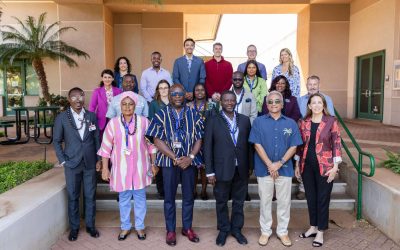Belize is home to an abundance of wildlife and scenic landscapes and draws thousands of visitors each year to its marine sanctuaries, tropical rain forests, and archeological sites. While the nation has taken significant steps to protect these resources from disaster risk—adopting both the United Nations’ Hyogo and Sendai Frameworks and undertaking protections through UNESCO—it remains highly vulnerable to the destructive forces of natural disasters. Facing hurricanes, flooding, coastal erosion, sea level rise, coral bleaching, and extended droughts, experts predict these challenges will only intensify as the age of extreme weather events continues to unfold. With an eye on sustainability and the need for reliable, scientific methods upon which to form future decisions, Belize has partnered with the Pacific Disaster Center (PDC) to help advance its resilience-building and sustainability initiatives.
Colonel Shelton De Four, National Emergency Coordinator of the Belize National Emergency Management Organization (NEMO), expressed excitement about the partnership with PDC. He said the collaboration will help Belize better understand national risk factors and preparedness at a local level, and provide a high-end suite of tools to help achieve resilience and sustainability goals. “In the end, this project will help us identify conditions throughout Belize that make communities vulnerable, and help decision makers in Belize to understand hazards, reduce vulnerabilities, and prioritize budgets focusing more on risk reduction,” remarked Colonel De Four. “Few countries in the region have the system, structure, programmes and tools that we have and produce the results that we do. However, we are not content. We have a long road ahead of us and high standards to accomplish,” he continued.
“One of the things that PDC has observed throughout our 20 years of international work is the need for reliable, understandable, and accessible information to guide the decision making process,” said PDC’s Director of Washington D.C. Operations Tim Manning. He described how PDC has structured its National Disaster Preparedness Baseline Assessment (NDPBA) program to meet those needs—providing both an in-depth assessment of risk and capacities to manage disasters at the national and subnational level, as well as the means to use assessment data operationally in daily decision making and planning. “We are pleased to be invited to work with the professional team in Belize to conduct our first workshop and exchange on the NDPBA. This project offers new learning opportunities for both parties and expands the network of countries working together to solve common problems through the NDPBA.”
The NDPBA was launched in partnership with NEMO and PDC on November 13, 2019, with a small workshop that garnered cross-sectoral participation from the nation’s health and natural resources ministries, the Belize Red Cross, the Prime Minister’s technology office, United Nations Development Programme, Caribbean Community Climate Change Center, Statistical Institute of Belize, University of Belize, and the National Meteorological Service to name a few of the agencies represented. According to many participants in the workshop, time is of the essence both for the country’s resilience and sustainability planning, and its ability to access timely and reliable information during a disaster event.
The NDPBA program will continue for a period of a year with continuous involvement from workshop stakeholders—culminating in a five-year strategy for action developed by PDC in partnership with the national government of Belize. PDC is a University of Hawaii applied science and research center that derives much of its expertise from its university ties and long-held international partnerships. The Center was established to improve the use of science, information, and technology in disaster preparedness and risk reduction following devastation to the Hawaiian island of Kauai by Hurricane Iniki in 1992. Today, PDC operates on a global platform to share advancements and innovations across national borders with the vision for a safer, more disaster resilient world.






